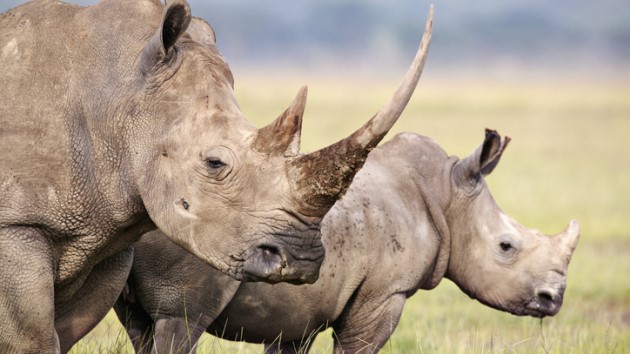(LONDON) — African rhino populations are increasing despite poaching and habitat loss, new figures from the International Union for Conservation of Nature (IUCN) show.
The new figures, released Thursday, highlight that protection and biological management initiatives across the continent have resulted in black rhino populations rising by 4.2% to a population of 6,487, and white rhino populations rising by 5.6% to a population of 16,803.
It is the first time since 2012 that there has been an increase in the white rhino population, the species classified as ‘near threatened’ on the IUCN’s Red List of threatened species.
“With this good news, we can take a sigh of relief for the first time in a decade,” said Dr. Michael Knight, chair of the IUCN’s Rhino Specialist Group (AfRSG). “However, it is imperative to further consolidate and build upon this positive development and not drop our guard.”
According to the World Wildlife Fund, there were 500,000 rhinos in Africa and Asia at the start of the 20th century. By the end of 2022, the African rhino population stood at just 23,290 according to latest figures by the IUCN.
However, thanks to “intense” and heightened protection and management efforts over the years, rhino populations on the continent are beginning to rebound.
“The rebounding rhino populations aren’t just a win for rhinos, but for the many wildlife species that share their ecosystems and the people who steward these lands,” Nina Fascione, Executive Director at the International Rhino Foundation, told ABC News.
“The growing rhino populations are a testament to the effectiveness of collaborative conservation efforts throughout Africa and the resilience of these species.”
Poaching, however, remains the biggest threat to all rhino species, as highlighted in the 2023 State of the Rhino report; poachers changing their tactics, focusing attention from the largest rhino population to more susceptible ones.
South Africa — home to the continent’s largest rhino population — has suffered “devastating poaching losses” as poachers target its reserves.
“Large, protected areas like Kruger National Park in South Africa have also greatly increased security measures to reduce the number of poaching incursions on their land,” says the International Rhino Foundation. “Poachers have reacted by targeting other, smaller areas, like province-run Hluhluwe Imfolozi Game Reserve, which has borne the brunt of South Africa’s rhino poaching deaths in the past year.”
Namibia — home to the world’s largest black rhino population — saw a devastating 93% increase in rhino poaching from 2021 to 2022.
In January, the U.S. treasury secretary announced the launch of a joint U.S.-South Africa anti-poaching taskforce to combat poaching, and increase sharing of financial intelligence units to support law enforcement agencies and disrupt illicit trade.
“We must follow the money in the same way we do with other serious crimes,” Yellen announced whilst touring South Africa’s Dinokeng Game Reserve.
Climate change also poses a growing risk to Africa’s rhino population as it’s devastating impacts on human communities has a ripple effect on wildlife and increases the risk of human-wildlife conflict.
“Competition over water resources may also cause increasing strife and disruption between communities and between humans and wildlife, bringing people in ever closer contact with rhinos,” says the IRF. “Poverty resulting from loss of crops and livestock may lead to increased poaching as a way to earn income.”
In early September, conservation group African Parks Foundation announced they are set to release 2,000 rhinos into the wild following the purchase of one of the world’s largest private captive rhino farms, Platinum Rhino.
It is set to be Africa’s largest rewilding programs of any species, set to take place over the next 10 years.
Only two surviving members of the critically endangered northern white rhino subspecies remain in the world — Najin and Fatu — both living under 24-hour protection in Kenya’s Ol-Pejeta Conservancy.
“Continuing a positive population trend for both black and white rhinos will require enormous efforts by governments, land managers, community members and others to ensure conservation actions surpass poaching,” says Fascione. “Rhinos have been around for millions of years — we cannot let them go extinct on our watch.”
Copyright © 2023, ABC Audio. All rights reserved.












